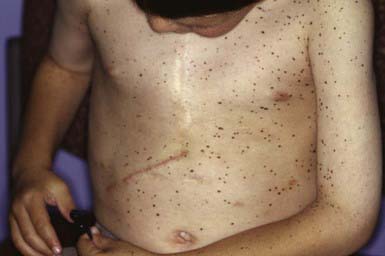Chapter 644 Hyperpigmented Lesions
Lentigines
Lentiginosis profusa involves innumerable small, pigmented macules that are present at birth or appear during childhood. There are no associated abnormalities, and mucous membranes are spared. LAMB syndrome (Carney complex), a multiple endocrine neoplasia syndrome, consists of lentigines of the face and vulva, atrial myxoma, mucocutaneous myxomas, and blue nevi (type 1, PRKAR1 gene; type 2, gene map locus 2p16-gene as yet to be identified). The Carney complex variant is associated with distal arthrogryposis (MYH8 gene). The multiple lentigines (LEOPARD) syndrome is an autosomal dominant entity consisting of a generalized, symmetric distribution of lentigines (Fig. 644-1) in association with electrocardiogram abnormalities, ocular hypertelorism, pulmonary stenosis, abnormal genitals (cryptorchidism, hypogonadism, hypospadias), growth retardation, and sensorineural deafness (type 1, PTPN11 gene; type 2, RAF1 gene). Other features include hypertrophic obstructive cardiomyopathy and pectus excavatum or carinatum.





